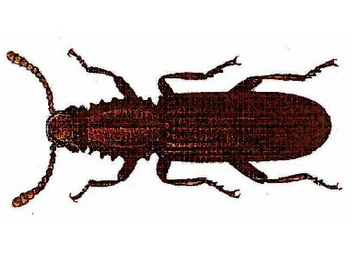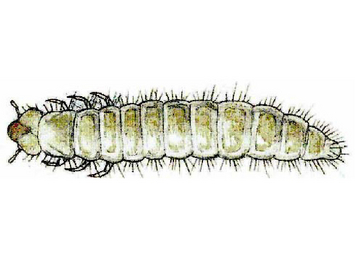Saw toothed grain beetle
Oryzaephilus surinamensis L
Profile
The grain weevil belongs to the flat weevil family. It is a secondary pest which, due to its small body size, requires the flour of broken grains for its nutrition, as it is unable to attack the intact hard shell of seeds. The beetle therefore does not exhibit a typical feeding pattern, but its presence is noticed by a typical, manure-like odor, which at high infestation densities is associated with an increase in temperature up to 40 °C within the stored material.
Appearance


The slender beetles, about 2.5 to 3 mm in size, are red to dark brown in color and are easily identifiable by three blunt longitudinal ribs and six denticles on each side of their neck shield. The movements of the beetles and larvae are nimble, almost ant-like. The adult beetles have limited flight ability.
The larvae are 3-4 mm in size and shiny yellowish.
Biology
The cereal narrow-headed beetle is also called cereal flat beetle and belongs to the flat beetle family(Cucujidae), as does the also common reddish-brown striped flat beetle (Cryptolestes ferugineus).
Females of the cereal sawtoothed beetle lay up to 300 eggs loosely among cereal grains. The larvae pass through four (or six under poor conditions) stages and then pupate in a small cavity in the food or in small crevices or cracks in the store. Development is possible between 19 °C and 38 °C.
Under optimal conditions (30 °C and 70-80 % relative humidity), the development of one generation takes less than one month, at 24 °C about two months. In dry conditions, the development time increases and at the same time the fecundity of females decreases. The life span of adult beetles is six to nine months at normal Central European temperatures.
Temperatures around -5 °C are endured for a few days. It must therefore be assumed that the pests can overwinter in unheated storage. The beetles have been detected sporadically outdoors in compost piles with appropriate fermentation heat, but cannot normally survive our winters outdoors.
Damage symptoms
The grain weevil eats mainly crumbs and therefore does not produce a typical feeding pattern. In the grain store, it is rarely found on the surface, so that its infestation is often only noticed very late.
At high infestation densities, the enormous feeding activity of beetles and larvae and the associated metabolic processes cause the temperature in the stored goods to rise to as high as 40°C. This is followed by the colonization of fungi and fungal growths. Fungi and bacteria then colonize the stored goods. The stored goods become inedible and take on a manure-like odor. The high temperatures in the stored goods cause condensation and the stored grain begins to grow out on the surface.
Host plants
The grain weevil and the larvae feed on various grain products of all kinds, flour, cereals, cookies, nuts, and other carbohydrate-rich foods. However, it also attacks oily seeds, dried fruit, or raisins.
As a secondary pest, it requires seeds that have already been damaged (broken cereals, gnawed grains), preferring to eat the seed embryo. Crumbly substrates such as flour are particularly favorable for larval development. The small size of the larvae and the young beetles, as well as their mobility, favor penetration of already packaged foods.
Propagation and transmission
The cereal leaf beetle originates from Surinam in South America and has been known in Germany since 1956. Due to the free trade in cereal products, it probably appeared in Austria soon thereafter. Since the beetles fly only very rarely, transmission occurs through cereal products contaminated with eggs or larvae.
Prevention and control
General hygiene measures
- Periodic and thorough cleaning of storage facilities
- Pest monitoring
- Temperature measurement in the stored goods
- Cooling (10-13 °C) and drying of the stored goods
- Disposal of junk and cleaning waste
- Destruction of already infested supplies
- mechanical prevention of beetles by sealing windows and doors (insect screens)
- Insulation of ceilings, walls and pipes (prevention of condensation)
- Plastering of crevices, cracks and porous walls
- Thorough cleaning of harvesting and transport machinery and storage rooms before storing the crop
- Empty space treatment with a plant protection agent (see list of plant protection agents approved in Austria) or heat treatment
Proof
- Periodic temperature measurement: a rise in temperature in the stored goods provides information about the presence of storage pests
- Sampling with a grain sampler
- Sieving of the samples with a continuous sieve
- Noise measurement: detection of larval feeding noises by inserting a sensitive microphone into the stored food.
Control
- Inert dusts (diatomaceous earth) and contact insecticides (see list of plant protection products approved in Austria) enable successful control of adult beetles and larvae if they are well distributed in the stored material (note: eggs already laid are not detected and lead to renewed infestation at temperatures above 19 °C).
- Reliable killing is achieved with gaseous preparations (phosphoric hydrogen, see list of plant protection products approved in Austria) and inert gases (nitrogen, carbon dioxide), provided that the stored goods to be treated are tightly sealed (note: specified dosages, temperatures and exposure times must be adhered to).
- Heat treatment (60 °C for three minutes) or cold treatment (below -10 °C) are possible, but only effective for smaller batches due to the high energy consumption.
Tips for household use
- Store food only in tightly closing storage containers with rubber seals or screw caps.
- Dispose of all infested food directly in the waste garbage can outside the house
- Remove bugs sitting around with a vacuum cleaner
- Fly screens on (roof) windows, doors and skylights reduce the risk of infestation
- At the moment, no suitable beneficial insect is approved for domestic use against the sawtoothed grain weevil (see list of plant protection products approved in Austria)
Last updated: 11.12.2025
automatically translated